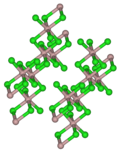Erbium(III) chloride is a violet solid with the formula ErCl3. It is used in the preparation of erbium metal. Anhydrous erbium(III) chloride can be produced...
6 KB (527 words) - 12:32, 29 December 2023
production of erbium metal prior to its reduction with calcium. Erbium(III) chloride is a violet compounds that can be formed by first heating erbium(III) oxide...
34 KB (4,095 words) - 04:24, 28 September 2024
corresponding erbium(III) salts. For example, with hydrochloric acid, the oxide follows the following idealized reaction leading to erbium chloride: Er2O3 +...
9 KB (841 words) - 03:26, 12 August 2024
luminescent materials. Erbium(III) chloride is a violet compounds that can be formed by first heating erbium(III) oxide and ammonium chloride to produce the ammonium...
14 KB (1,392 words) - 00:25, 20 May 2024
It can be obtained by the reaction of erbium and tellurium or the chemical vapor transport of erbium(III) chloride. Klaus Stöwe (May 1998). "Kristallstruktur...
2 KB (240 words) - 17:50, 18 July 2024
Holmium(III) chloride is the inorganic compound with the formula HoCl3. It is a common salt but is mainly used in research. It can be used to produce...
4 KB (303 words) - 11:23, 8 July 2023
Thulium(III) chloride or thulium trichloride is as an inorganic salt composed of thulium and chlorine with the formula TmCl3. It forms yellow crystals...
6 KB (375 words) - 23:50, 26 August 2023
Dysprosium(III) chloride – DyCl3 Erbium(III) chloride – ErCl3 Europium(II) chloride – EuCl2 Europium(III) chloride – EuCl3 Gadolinium(III) chloride – GdCl3...
119 KB (8,735 words) - 14:26, 16 September 2024
Dysprosium(III) selenide can be prepared by reacting dysprosium(III) oxide or dysprosium(III) chloride with hydrogen selenide: Dy2O3 + 3 H2Se → Dy2Se3 + 3 H2O...
2 KB (148 words) - 17:51, 21 January 2024
number ErB4 erbium(III) boride 12310–44–0 ErBr3 erbium(III) bromide 13536–73–7 Er(CHO2)3 erbium(III) formate 15331–72–3 ErCl3 erbium(III) chloride 10138–41–7...
139 KB (120 words) - 17:07, 15 July 2024
erbium(III) chloride 10138-41-7 ErF erbium monofluoride 16087-67-5 ErF2 erbium difluoride 16087-65-3 ErF3 erbium trifluoride 13760-83-3 ErI3 erbium triiodide...
183 KB (107 words) - 22:11, 6 September 2024
known. The oxide, also called holmia, occurs as a component of the related erbium oxide mineral called erbia. Typically, the oxides of the trivalent lanthanides...
14 KB (1,188 words) - 19:39, 21 August 2024
(1966). "Pharmacology and toxicology of dysprosium, holmium, and erbium chlorides". Toxicology and Applied Pharmacology. 8 (1): 37–43. Bibcode:1966ToxAP...
36 KB (4,143 words) - 22:51, 11 September 2024
the "interpenetrating primitive cubic" structure, also called a "caesium chloride" or B2 structure. This structure is often confused for a body-centered...
49 KB (3,620 words) - 23:33, 27 September 2024
Nitrate chlorides are mixed anion compounds that contain both nitrate (NO3−) and chloride (Cl−) ions. Various compounds are known, including amino acid...
63 KB (3,736 words) - 14:02, 19 September 2024
Chromium (redirect from Chromium(III))
oxidize to chromium(III) derivatives in air. Water-stable chromium(II) chloride CrCl 2 that can be made by reducing chromium(III) chloride with zinc. The resulting...
109 KB (11,824 words) - 01:53, 10 September 2024
yttrium forms trihalides such as yttrium(III) fluoride (YF 3), yttrium(III) chloride (YCl 3), and yttrium(III) bromide (YBr 3) at temperatures above roughly...
58 KB (6,666 words) - 17:30, 28 September 2024
Ytterbium (section Yb(II) vs. Yb(III))
Ytterby, the village in Sweden near where he found the new component of erbium. He suspected that ytterbia was a compound of a new element that he called...
41 KB (5,200 words) - 10:29, 13 August 2024
Lanthanide trifluoromethanesulfonates (redirect from Erbium(III) triflate)
acid catalysts. These catalysts function similarly to aluminium chloride or ferric chloride, but they are water-tolerant (stable in water). Commonly written...
8 KB (924 words) - 07:50, 18 October 2023
beta emission. The primary decay products before 169Tm are element 68 (erbium) isotopes, and the primary products after are element 70 (ytterbium) isotopes...
28 KB (3,250 words) - 02:38, 16 August 2024
as an impurity in yttrium oxide, Y2O3. Yttrium and terbium, as well as erbium and ytterbium, are named after the village of Ytterby in Sweden. Terbium...
41 KB (5,005 words) - 19:55, 7 September 2024
isomers, the second of which, 149m2Dy, has a half-life of 28 ns. In 1878, erbium ores were found to contain the oxides of holmium and thulium. French chemist...
37 KB (4,332 words) - 12:03, 15 September 2024
Thallium (section Thallium(III))
Thallium(III) sesquichalcogenides do not exist. The thallium(I) halides are stable. In keeping with the large size of the Tl+ cation, the chloride and bromide...
52 KB (5,786 words) - 12:33, 28 September 2024
iron(III) fluoride even in cold temperatures. When chlorine comes into contact with a heated iron, they react to form the black iron(III) chloride. However...
52 KB (5,499 words) - 18:00, 11 September 2024
tetrakis(methylammonium) hexachloroferrate(III) chloride (I) and tetrakis(hexamethylenediammonium) hexachloroferrate(III) tetrachloroferrate(III) tetrachloride (II)". Inorganica...
150 KB (17,056 words) - 12:22, 24 August 2024
structure between the halogens. So, chloride (AmCl3) is reddish and has a structure isotypic to uranium(III) chloride (space group P63/m) and the melting...
76 KB (9,245 words) - 12:39, 16 September 2024
Copper (redirect from Copper(III))
methods are used including leaching with sulfuric acid, ammonia, ferric chloride. Biological methods are also used. A significant source of copper is from...
122 KB (13,883 words) - 03:24, 5 September 2024
Protactinium (redirect from Protactinium chloride)
protactinium(IV) fluoride and dodecahedral in the chloride and bromide. Brown-colored protactinium(III) iodide has been reported, where protactinium ions...
50 KB (5,825 words) - 10:07, 25 September 2024
Europium (section Eu(II) vs. Eu(III))
white europium(III) fluoride (EuF3), yellow europium(III) chloride (EuCl3), gray europium(III) bromide (EuBr3), and colorless europium(III) iodide (EuI3)...
38 KB (4,709 words) - 22:39, 9 August 2024
the californium(III) cation. Attempts to reduce or oxidize the +3 ion in solution have failed. The element forms a water-soluble chloride, nitrate, perchlorate...
44 KB (4,609 words) - 23:46, 21 August 2024





















